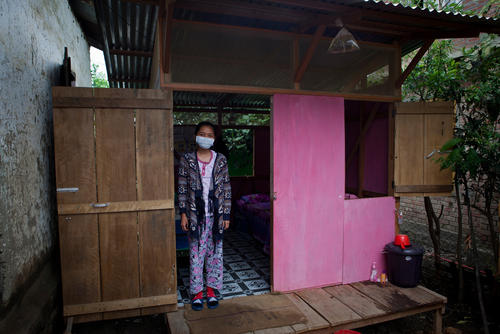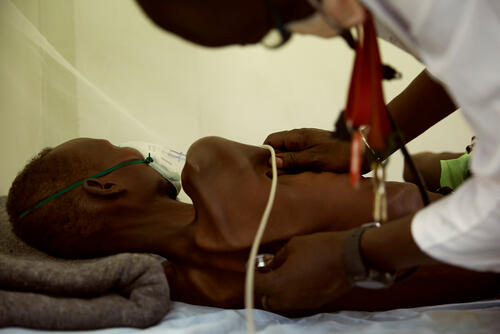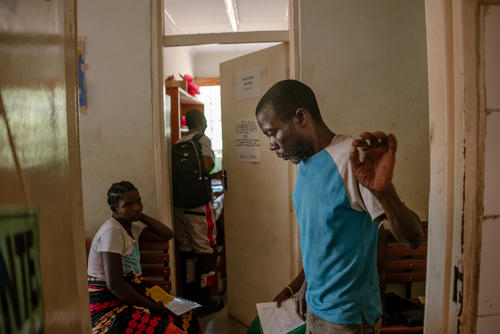About the report
MSF provides treatment for HIV and tuberculosis (TB) in more than 20 countries around the world. The report Burden sharing or burden shifting? How the HIV/TB response is being derailed examines the situation in nine countries where MSF runs programmes: Central African Republic, Democratic Republic of Congo, Eswatini, Guinea, Kenya, Malawi, Mozambique, Myanmar and Zimbabwe.While MSF also provides HIV and TB treatment in countries not included in the report, the countries selected have an especially high burden of HIV and TB co-infection. With a focus on the financial resources available, this report highlights the current risks and gaps in HIV and TB service delivery in these countries.
Given the findings of gaps in diagnosis, prevention and care services and dwindling resources, MSF calls for a robust assessment of the needs and the resource capacity of each affected country, and calls on international donors to ensure that the financial burden is shared, rather than shifted onto those countries worst affected by the diseases.
1.7 M
1.7M
770,000
770,
10 M
1M
1.6 M
1.6M
4.1 M
4.1M
HIV and TB epidemics are still major killers, and AIDS is making a comeback
HIV/AIDS and TB remain the two deadliest infectious diseases today, in spite of being treatable. Nearly 1.7 million people are infected with HIV each year, while 30,000 people fall ill with TB every day. HIV/AIDS was responsible for 770,000 deaths in 2018, while TB killed 1.6 million people in 2017 (300,000 of whom were HIV-positive). The annual number of deaths due to AIDS has declined only minimally since 2014. At the same time, an estimated 4.1 million TB cases go undetected and untreated each year.Sources: <a href="https://www.unaids.org/sites/default/files/media_asset/2019-UNAIDS-data_en.pdf">UNAIDS Data 2019</a> and <a href="http://apps.who.int/iris/bitstream/handle/10665/274453/9789241565646-eng.pdf> Global TB report 2018</a>
Today’s challenges of treating HIV and TB are still daunting. These include: an increasing number of people on lifelong antiretroviral (ARV) treatment; rising resistance to first-line treatments, requiring a switch to more expensive second and third-line regimens; more cases of drug-resistant TB, fuelling a growing public health crisis; and a shortage of funding to treat people with HIV/TB in countries with a lower HIV prevalence, for example countries in West and Central Africa, which have received too little assistance and whose progress is now lagging behind. Worse still, Advanced HIV Disease (AHD) or AIDS is returning in many places, with at least 33 per cent of HIV-positive people worldwide having a CD4 count of below 200 when starting ARV treatment.WHO defines Advanced HIV Disease (AHD) as patients with a CD4 cell count below 200 cells/mm3 or a World Health Organization (WHO) clinical stage 3 or 4 or all children under the age of 5 years at the presentation of care. For more information, see WHO’s Guidelines for managing advanced HIV disease and rapid initiation of antiretroviral therapy, WHO, July 2017
HIV and TB financing trends not aligned with needs
After 10 years of steady global political investment and a firm commitment to end the epidemics of HIV and TB by 2030Target 3.3 of the SDG 3 on Health calls for ending by 2030 the epidemics of AIDS, TB, malaria and neglected tropical diseases, and combating hepatitis, water-borne diseases and other communicable diseases. , recent data indicates that national and global responses are veering off track, which risks reversing the lifesaving gains made so far.
For the first time in a decade, funding for HIV programmes (from both domestic and international sources) declined in 2018, falling by US$1 billion in low and middle-income countries,Communities at the center – Global AIDS Update 2019, UNAIDS, July 2019. while the funding gap for TB programmes widened further, reaching US$3.5 billion per year.OpCit. Global Tuberculosis Report 2018, WHO 2019, pages 115, 117. Following a levelling off period, international assistance for HIV and TB dropped by 9% and 12% respectively between 2017 and 2018.Financing global health 2018 – Countries and programs in transition, Institute of Health Metrics and Evaluations (IHME), Seattle, WA, IHME, 2019, page 47.
By contrast, domestic funding for HIV has increased gradually over the past decade, but combined resources for HIV for the worst affected countries still fall woefully short. The annual investment of $26 billion needed to reach the 2030 HIV target reached just $19 billion in 2018. While the total funds needed for TB programmes were estimated at $10.4 billion in 2018, just $6.9 billion was available that year.
The Global Fund to Fight AIDS, Tuberculosis and Malaria (the Global Fund) – one of the most important funders of the HIV and TB response – aims to mobilise at least $14 billion of the total $101 billion needed for the supported HIV, TB and malaria programmes for 2021-23.
With an additional $46 billion from domestic funds and $23 billion from other external funders, this still only covers 82 per cent of the needs, leaving a shortfall of $10 billion for TB, $4.4 billion for HIV and $3.4 billion for malaria.Global Fund Investment Case Summary Sixth Replenishment Moreover, the expected contribution from domestic funds, which represents an increase of 48 per cent by 2023, remains yet to be confirmed.
Against a backdrop of waning international assistance, the call for increased domestic funding has grown stronger. However, the ability of countries to increase domestic funding in the short term varies. According to a recent study published in the Lancet,Potential for additional government spending on HIV/AIDS in 137 low-income and middle-income countries: an economic modeling study, Haakenstad et al. The Lancet, 26 April, 2019. https://www.thelancet.com/action/showPdf?pii=S2352-3018%2819%2930038-4 many low- and middle-income countries are considered unlikely to be able to replace even 10 per cent of the current international contributions toward HIV/ADS care and treatment, potentially leaving some five million patients on ARV treatment either to self-finance care or to stop treatment altogether.
Consequences of funding shortfalls for the HIV and TB response: a reality check in nine countries
The findings of MSF’s reportInformation was collected through literature reviews and semi-structured interviews with key informants at both national and international levels. indicate that our teams and partners are already observing persistent and expanding gaps in essential prevention, diagnostic and treatment services. These include: insufficient health workers; stockouts and shortages of essential medicines; and shortfalls in programmes targeting people with specific needs, such as people with advanced HIV disease, people who inject drugs and migrant populations.
Main findings:
- Access to quality lifesaving HIV and TB treatment is in jeopardy
- Case finding and diagnosis activities are underfunded
- There is insufficient investment in prevention activities and health promotion
- Community programmes and psychosocial support face deficits
- Shortfalls exist of health workers and supply chain management.
Some examples from the case studies:
In West and Central Africa, where many countries are lagging far behind in their HIV and TB responses, only 48 per cent of HIV funding needed by 2020 is available. In countries including Democratic Republic of Congo, Central African Republic and Guinea, the need and capacity to scale up ARV treatment is outpacing the funding available; during recent widespread ARV stockouts and shortages, MSF had to step in to provide support in CAR and Guinea.
In Guinea, due to the lack of funds, HIV testing has become less available at testing centres. Plans were developed for key populations and prevention of mother-to-child transmission (PMTCT) but testing campaigns in the community in 2018 had to be cancelled due to a shortage of health commodities. With the health system still recovering from the 2014-16 Ebola epidemic, factors including a lack of buffer stock and delays in orders contributed to an interruption in the supply of ARV drugs in 2018.
Effective health responses pitted against each other, leading to impossible choices
While funding shortfalls are not the only barriers to accelerating progress– legal and cultural barriers and restrictive policies also need to be removed – they have a negative impact on the HIV/TB response, lead to rationing and competition between key service areas and hamper scale-up and the adoption of innovative approaches.
These and other hurdles contribute to delayed or interrupted treatment, increased transmission, higher mortality and a rise in drug resistance – all of which further increase the cost of care. Patients also risk being pushed further into poverty by having to pay for treatment out of their own pockets.
An overall lack of financial resources also tends to exacerbate existing tensions between prevention and treatment, even though both are two sides of the same coin. Without effectively scaling up prevention, higher incidence rates will increase the stress on national treatment programmes. Gaps in treatment scale-up will undermine the prevention spin-off effects as well as the credibility of the health system as a whole. At community level, we have seen cuts in mobilisation and awareness efforts.
At policy level, a focus on disease programmes is often wrongly perceived as competing with the goals of strengthening the health system and achieving universal health coverage. Ultimately, shortfalls in funding lead to necessary, effective health interventions being pitted against each other. Essential healthcare risks being framed as dispensable and dependent on what can be afforded.
International mobilisation is needed as countries struggle to compensate for decline in external support
Nowadays there is a widespread assumption that progress towards HIV and TB targets and universal healthcare should primarily be achieved by an increase in domestic funding. However, in the light of recent trends in the mobilisation of domestic and international financial resources, this assumption needs to be re-examined. In many countries, such as those included in our review, even if political will may exist, there are often not many viable options for them to do so, certainly not in the short term. Countries with economies under strain, a limited tax base and restricted fiscal space already face significant shortfalls in financial resources and struggle to reach projected government health expenditures.
Bilateral donors, the Global Fund and PEFPAR have high expectations for countries, including lower- income countries, to progressively increase investments in HIV and TB programmes, including recurrent costs such as purchasing medical supplies and paying staff. While in principle this shift is intended to lead to greater country ownership and financial independence, it should be informed by rigorous assessments of countries’ readiness in terms of their financial and technical capacity, in order to avoid putting people’s lives at risk if service provision declines or is disrupted, and to ensure a stable supply of affordable and high-quality treatment.Mercedes Tatay & Els Torreele, Ensuring access to life-saving medicines as countries shift from Global Fund support. Bulletin of the World Health Organization 2019; 97:311-311A.
Ultimately, the focus must be on global burden sharing, and on what needs to be done, rather than on premature exit tactics. International discourse currently appears to underplay the impact of the funding shortfall. Financial investments must become more ambitious and must take into consideration what is both feasible and equitable.
With a little more than a year remaining before the 2020 global targets in the fight against HIV and TB are due to be met (i.e. the three 90sUNAIDS treatment target means that by 2020, 90% of all people living with HIV should know their HIV status; 90% of all people with diagnosed HIV infection should receive sustained antiretroviral therapy; and, 90% of all people receiving antiretroviral therapy will have viral suppression. and reducing TB-related deaths, including among people living with HIV, by 75 per centPolitical declaration on HIV and AIDS: On the fast track to accelerating the fight against HIV and to ending the AIDS epidemic by 2030, 2016 https://www.unaids.org/sites/default/files/media_asset/2016-political-declaration-HIV-AIDS_en.pdf Political declaration on the fight against tuberculosis, 2018 https://www.un.org/pga/72/wp-content/uploads/sites/51/2018/09/Co-facilitators-Revised-text-Political-Declaraion-on-the-Fight-against-Tuberculosis.pdf ), many countries still remain far off target.<a href="https://www.unaids.org/sites/default/files/media_asset/tuberculosis-and-hiv-progress-towards-the-2020-target_en.pdf> Progress towards the 2020 target, UNAIDS</a> The world is at a critical juncture for preventing the HIV and TB response from veering further off track.
As the Global Fund has highlighted, if treatment and prevention efforts for HIV, TB and malaria continue at current levels, we will face a rebound in incidence and mortality caused by these epidemics.Global Fund Investment Case Summary Sixth Replenishment,https://www.theglobalfund.org/media/8174/publication_sixthreplenishmentinvestmentcase_summary_en.pdf Each delay in reducing the incidence and mortality means more infections, more deaths and more human, health and economic costs – both in the medium and long term.
This is why we recommend:
- Stepping up efforts to keep the HIV and TB responses high on the agenda, and increasing investments in reducing transmission, morbidity and mortality related to HIV and TB.
- Committing to reverse the decline in international funding for HIV and TB and to meet the Global Fund’s replenishment target of raising at least US$14 billion for the 2020-22 period. Also needed is continued strong engagement in comprehensive HIV and TB services by the US government and the re-engagement of other bilateral donors and the World Bank.
- Restating the key challenges of bringing the HIV and TB response back on track, based on a realistic assessment of the state of the epidemics, the availability of funding and countries’ needs. This should include acknowledging current and future gaps in HIV and TB programmes and funding shifts, along with the urgent need for measures to mitigate them.
- Organising multi-stakeholder meetings with a focus on those countries which face major funding gaps in their HIV and TB response over the coming years, to gauge the consequences and risks, to explore mitigating strategies and to explore potential international efforts to help bridge the gaps in this critical period.
- Within universal health coverage (UHC) endeavours, ensuring financial protection for patients, promoting equitable access to patient-centred and community-oriented services that include the specific vulnerabilities and needs of people living with HIV and/or TB.






